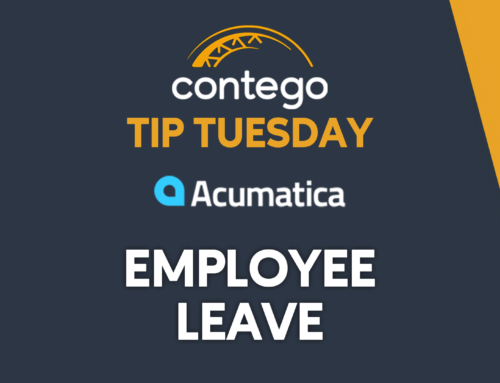Acumatica vs. Microsoft Dynamics SL
Which One is Right for You?
In today’s digital economy, technology continues to advance at warp speed, and it’s mission-critical for you, as a small or midsized business (SMB), to make sure your business management solution can help you successfully compete. If it can’t, then it’s past time to consider how advanced technology—such as a comprehensive Enterprise Resource Planning (ERP) solution—can help.
In short, a modern ERP solution streamlines business processes, seamlessly integrates with third-party applications, and stores organizational data in one, centralized platform, providing you with a complete view into—and accurate information about—every aspect of your operation. It’s game-changing technology, but knowing which ERP solution is right for you requires extensive research into your many ERP options, including two widely used platforms: Acumatica Cloud ERP and Microsoft Dynamics SL.
To help with your research, we’re providing an Acumatica vs. Dynamics SL comparison today, and we’re exploring how Microsoft Dynamics SL users will be affected by Microsoft’s decision to stop providing mainstream support for the software on January 9, 2024.
Microsoft or Acumatica: Factors to Consider
Acumatica and Microsoft Dynamics SL offer users efficient ways to manage finance-, distribution-, service-, and project-based needs. But there are some very significant differences between the two systems.
Pricing
Pricing is always a major point of comparison. Buyers usually have a clear budget in mind when beginning their ERP research project, but they often believe comparing pricing is a relatively easy first step. Unfortunately, pricing is more complex than asking how much a solution costs.
Microsoft Dynamics SL requires businesses to buy a concurrent license for each user. This means that, every time you add a new employee, partner, or vendor, you must purchase a new license. In comparison, Acumatica’s pricing structure is based on resource usage, not total users. Acumatica’s price is calculated according to the following three factors, which its customers can change at any time, with no penalty:
- The applications you want to start using now.
- The type of license you are considering.
- Your projected resource consumption.
Paying “only for the functionality you need, not for user seats,” fuels unlimited growth without fear of how much that growth will cost.
Features
Today’s savvy buyers are searching for a comprehensive ERP system with the features, modules, and applications they need for their unique business requirements. Microsoft Dynamics SL is a very project-focused solution, with a strong emphasis on project and financial management, supply chain management, and business intelligence.
Acumatica, believing that no product is “one size fits all,” provides these standard features in its project-focused Manufacturing and Construction Editions, but the base Acumatica Cloud ERP software is equipped with open APIs that allow for near-infinite customizability.
It can also be combined with other powerful modules—like Acumatica’s Warehouse Management System (WMS) and Customer Relationship Management (CRM) modules. And the Acumatica Marketplace is filled with hundreds of robust add-ons, developed by Acumatica’s ecosystem of technology partners and designed to meet customers’ specific needs. You can check out Excel-based reporting by Velixo, Acumatica’s Native Shopify Integration, and much more.
Functionality
Though Microsoft advertises Microsoft Dynamics SL as a system that provides users with a quick start up, mobility, scalability, and inclusive project and accounting management, it’s functionality is limited. Microsoft Dynamics SL does not provide:
- Multiple deployment options (e.g., cloud, on-premises, or hybrid).
- Seamless integration with the latest technologies.
- Constant innovations that keep users at the forefront of ERP technology.
But Acumatica provides all this and more.
Microsoft Dynamics SL End of Life
Beyond these distinguishing factors, the biggest, most impactful difference when comparing Acumatica vs. Dynamics SL is the fact that the latter solution is being slowly but systematically phased out.
According to an MS Dynamics World article, SL 2018 will receive two more updates—one in June 2023 and the final one in December 2023. Mainstream support for Dynamics SL will end in January 2024.
Author Jason Gumpert writes: “Once SL passes from mainstream support to extended support, Microsoft will provide only security patches, but no more year end updates (including the end of 2024). Existing customers can continue to buy new users or modules during extended support.”
Gumpert also says that Microsoft’s “recommended path forward is a move to Dynamics 365 Business Central.” Unfortunately, there is no migration path between Dynamics SL and Dynamics 365 Business Central. It is a complete implementation from scratch. But you have another option. Cut your ties with Dynamics completely and implement Acumatica’s comprehensive, constantly updated, always current Cloud ERP solution.
Acumatica: The Go-To Alternative
With Acumatica, you’ll benefit from a powerful ERP platform with a flexible and affordable pricing structure and some of the most valuable customization options in the industry. As a fully cloud-based solution, Acumatica is a great option that requires no new tools, software, or equipment to set up, allowing Dynamics SL users to keep their Microsoft suite workflows and current tech stacks.
Ultimately, if you’re deciding between Microsoft or Acumatica, examine their pricing, features, and functionality. And remember that both updates and support will soon stop for Microsoft Dynamics SL.
To learn more about Acumatica, contact us at Contego, a Gold Certified Acumatica partner with Microsoft Dynamics SL experience.




